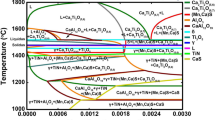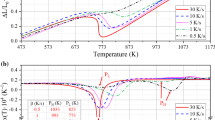Abstract
The energy crisis has created the need to develop steels with better strength-toughness combinations than ever before to meet the stringent criteria for various applications in the energy production, transportation and usage. “Effective” grain size being one of the main factors that can simultaneously improve strength as well as toughness, the control of the final microstructure and the substructure of the steels has received considerable attention, particularly in the last few years. As a result many new thermochemical treatment techniques and compositional modifications have evolved to control the austenite grain size and morphology and in turn to control the final ferrite grain size and substructure. The paper reviews the state of art of structural improvement of plain carbon and HSLA steels discusses the underlying principles and mechanisms, points out the limitations of the present theoretical knowledge with reference to its application to commercial steels particularly, in the area of predicting the final structure when multiple alloying additions and/or complex thermomechanical processing techniques are involved. Potential areas of research are indicated. Finally the work being carried out at Laval in the area of structural control of carbon and HSLA steels are briefly discussed.
Similar content being viewed by others
References
I. LeMay, M. R. Krishnadev, and A. Galibois:Oil Gas J., 1974, vol. 72, no. 50, p. 48.
Y. E. Smith, A. P. Coldren, and R. L. Cryderman:Toward Improved Ductility and Toughness, p. 119. Climax Molybdenum Development Co. Ltd., Kyoto, Japan, 1972.
M. Fakuda, T. Hashimoto, and K. Kunishige:The Sumitomo Search, 1973, vol. 9, p. 8.
M. Fakuda, T. Hashimoto, and K. Kunishige:Microalloying 75-History and Theory, p. 115. Union Carbide Corporation, N.Y., 1975.
T. Gladman and D. Dulieu,Metal Sci., 1974, vol. 8, p. 167.
K. J. Irvine, T. Gladman, J. Orr, and F. B. Pickering:J. Iron Steel Inst., 1970, vol. 208, p. 717.
J. J. Irani, D. Dulieu, and G. Tither:Low Alloy Steels, ISI Publication No. 114 p. 75, London, U.K., 1986.
R. F. Dewsnap:J. Iron Steel Inst., 1970, vol. 208, p. 727.
E. R. Parker and J. Washburm:Impurities and Imperfections, p. 155. ASM, Metal Park, Ohio, 1955.
J. H. Mihelich and J. H. Smith:Source Book on Materials Selection, vol. 1, p. 221, ASM, Metals Park, Ohio, 1977.
J. M. Gray,Processing and Properties of Low Carbon Steel, J. M. Gray, ed., p. 225, AIME, New York, 1973.
D. Webster: “The Effect of Dispersed Particles on Grain Boundary Movement in Steel”, Ph.D. Thesis, University of Sheffield, U.K., July, 1965.
P. P. Hydrean, J. E. Chard, and C. H. Shelton: “Mechanical Working and Steel ProcessingX”Proceedings of the A.I.M.E. Fourteenth Mechanical Working and Steel Processing Conference, Jan. 19, 1972, Chicago, Ill., p. 211, AIME, New York, 1972.
J. L. Hurley and C. H. Shelton:Metal Eng. Quart., 1966, vol. 6, p. 25.
K. J. Blom: “FAMA, The New Structural Steels”, Fagersta Bruks AB, Sweden, 1970.
D. F. Baxter, Jr.: “GM Develops a Superformable HSLA Steel”Metal Progr., August 1977, vol. 112, no. 3, p. 44.
M. R. Krishnadev and A. Galibois:Metals Technol., June 1974, vol. 1, no. 6, p. 300.
M. R. Krishnadev and A. Galibois:Met. Trans., 1975, vol. 6A, p. 222.
M. R. Krishnadev and A. Galibois:Microstructural Science, G. P. Fritzke,et al., eds, vol. 5, p. 79, Elsevir, 1974.
M. R. Krishnadev and A. Galibois:Proceedings of the IVth Inter-American Conference on Materials Technology, p. 369, Publishers CRDAT, Mexico, 1975, Caracas, Venezuela, July 1975.
M. R. Krishnadev: “Extra Low Carbon-Copper-Manganese-Columbium High Strength Steel”, Canadian Patent No. 9888751, 1976.
M. R. Krishnadev: Unpublished research, Laval University, Québec, Canada, 1978.
M. R. Krishnadev: INCRA Project No. 244, INCRA, N.Y., October 1974.
M. R. Krishnadev: Unpublished research, Laval University, Québec, Canada, 1978.
L. R. Cutler and M. R. Krishnadev: “Metallography and Aging Characteristics of a Cu−Cb−Ti HSLA Steel”,Microstructural Science, I. LeMay, ed., vol. 7, Elsevir, p. 111, 1979.
L. R. Cutler: “Effect of Thermo Mechanical Processing on Microstructure and Mechanical Properties of a Cu−Cb−P−Ti HSLA Steel”, M. Sc. Thesis, Laval University, Québec, Canada, December 1978.
M. Durbin and P. R. Krahe:Processing and Properties of Low Carbon Steel, p. 109, AIME, N.Y, 1973.
Author information
Authors and Affiliations
Additional information
A. DUBÉ, now deceased, was formerly Professor, Department of Metallurgy, Laval University, Québec, G1K 7P4, Canada.
This paper is based on a presentation made at a symposium on “Recovery, Recrystallization and Grain Growth in Material’ held at the Chicago meeting of The Metallurgical Socieyty of AIME, October 1977, under the sponsorship of the Physical Metallurgy Committee.
Rights and permissions
About this article
Cite this article
Galibois, A., Krishnadev, M.R. & Dubé, A. Control of grain size and sub-structure in plain carbon and high strength low alloy (HSLA) steels—the problem and the prospect. Metall Trans A 10, 985–995 (1979). https://doi.org/10.1007/BF02811645
Issue Date:
DOI: https://doi.org/10.1007/BF02811645




